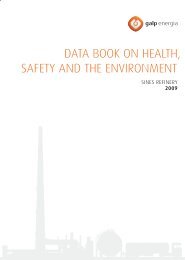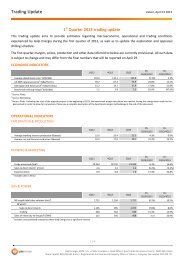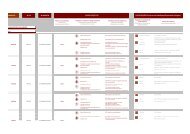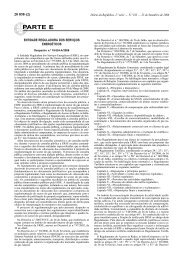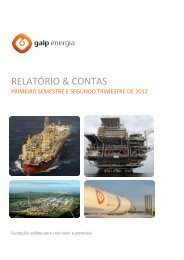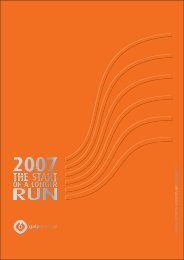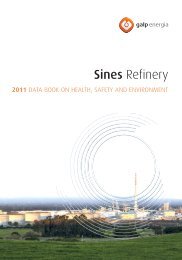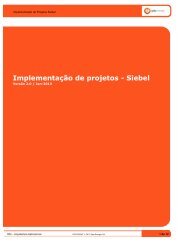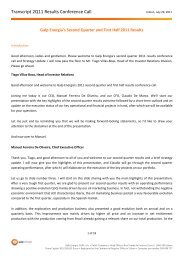Safety Data Sheet - Galp Energia
Safety Data Sheet - Galp Energia
Safety Data Sheet - Galp Energia
Create successful ePaper yourself
Turn your PDF publications into a flip-book with our unique Google optimized e-Paper software.
DR<br />
<strong>Safety</strong> <strong>Data</strong> <strong>Sheet</strong><br />
according to Regulation 1907/2006/EC, Article 31<br />
Page 1/13<br />
Printing date 19.01.2012 rev nº 1.1<br />
Revision: 19.01.2012<br />
1 Identification of the substance/mixture and of the company/undertaking<br />
Product identifier Asphalt.<br />
Trade name: Asphalt<br />
Other names of the product:<br />
ASPHALTIC BITUMEN GALP 10/20<br />
ASPHALTIC BITUMEN GALP 35/50<br />
ASPHALTIC BITUMEN GALP 50/70, ASPHALTIC BITUMEN GALP 60/70<br />
ASPHALTIC BITUMEN GALP 160/220<br />
Product <strong>Safety</strong> number: BET-014<br />
Shipping document (marine transportation only)<br />
supplied by the concerned commercial department (for marine transportation only).<br />
CAS Number:<br />
8052-42-4<br />
EC number:<br />
232-490-9<br />
Registration number 01-2119480172-44-0050<br />
Relevant identified uses of the substance or mixture and uses advised against<br />
Uses not included in next item are not advised.<br />
Application of the substance / the preparation<br />
Industrial use:<br />
Manufacture of Substance.<br />
Distribution of substance.<br />
Formulation & (re)packing of substances and mixtures.<br />
Uses in Coatings.<br />
Professional use:<br />
Uses in Coatings.<br />
Road and construction applications.<br />
Consumer use:<br />
Uses in Coatings.<br />
Details of the supplier of the safety data sheet<br />
Manufacturer/Supplier:<br />
Petróleos de Portugal - Petrogal, S.A.<br />
R. Tomás da Fonseca, Torre C, 1600-209 Lisboa, Portugal<br />
Tel: (351) 21 724 25 00<br />
Fax: (351) 21 724 29 65<br />
e-mail: ambiente.qualidade.seguranca@galpenergia.com<br />
Emergency telephone number: 112<br />
2 Hazards identification<br />
Classification of the substance or mixture<br />
Classification according to Regulation (EC) No 1272/2008<br />
The product is not classified as hazardous to health or environment according to the CLP<br />
regulation.<br />
Void<br />
Classification according to Directive 67/548/EEC or Directive 1999/45/EC<br />
The product is not classified as dangerous according to the calculation procedure of the<br />
"General Classification guideline for preparations of the EU" in the latest valid version.<br />
Void
DR<br />
<strong>Safety</strong> <strong>Data</strong> <strong>Sheet</strong><br />
according to Regulation 1907/2006/EC, Article 31<br />
Page 2/13<br />
Printing date 19.01.2012 rev nº 1.1<br />
Revision: 19.01.2012<br />
Trade name: Asphalt<br />
Information concerning particular hazards for human and environment:<br />
At ambient temperature the product present no human health hazards.<br />
The product is normally handled at elevated temperature which may cause thermal burns.<br />
In the heated state it gives off fumes. Although these are not thought to produce a significant<br />
health hazard, prudence would dictate that exposure to these fumes should be kept to a<br />
minimum by observing good work practice and ensuring good ventilation around work areas.<br />
Hydrogen sulphide can accumulate in the head space of storage tanks and can reach<br />
potentially hazardous concentrations.<br />
The bitumen is stored and handled at elevated temperatures.<br />
Contact of hot product with water will result in a violent expansion as the water turns to<br />
steam, and this may cause damage to, or complete loss of, the tank roof.<br />
Although not classified as flammable, the product is made up of hydrocarbons which can<br />
burn.<br />
Label elements<br />
Labelling according to Regulation (EC) No 1272/2008<br />
Not applicable.<br />
Hazard pictograms<br />
Not applicable.<br />
Signal word<br />
Not applicable.<br />
Hazard-determining components of labelling: Not applicable.<br />
Hazard statements<br />
Not applicable.<br />
Other hazards<br />
Vapours or mist, in excess of permissible concentrations, or in unusually high concentrations<br />
generated from spraying, heating the material or from exposure in poorly ventilated areas or<br />
confined spaces, may cause irritation of the nose and throat, headache, nausea, and drowsiness.<br />
Results of PBT and vPvB assessment<br />
PBT: Not applicable.<br />
vPvB: Not applicable.<br />
3 Composition/information on ingredients<br />
Chemical characterization: Substances<br />
CAS No. and name:<br />
8052-42-4 Asphalt<br />
Identification number(s)<br />
EC number: 232-490-9<br />
4 First aid measures<br />
Description of first aid measures<br />
General information:<br />
Contact with hot bitumen may cause severe thermal burns.<br />
Hydrogen sulphide (H2S) can accumulate in the headspace of product storage tanks and reach<br />
potentially hazardous concentrations.
DR<br />
<strong>Safety</strong> <strong>Data</strong> <strong>Sheet</strong><br />
according to Regulation 1907/2006/EC, Article 31<br />
Page 3/13<br />
Printing date 19.01.2012 rev nº 1.1<br />
Revision: 19.01.2012<br />
Trade name: Asphalt<br />
After inhalation:<br />
Symptoms:<br />
Irritation of the respiratory tract due to excess fume, mists or vapour exposure.<br />
In case of symptoms arising from inhalation of product fumes, mists or vapour :<br />
remove casualty to a quiet and well ventilated place if safe to do so.<br />
If casualty is unconscious and:<br />
Not breathing:<br />
Ensure that there is no obstruction to breathing and give artificial respiration by trained<br />
personnel.<br />
If necessary, give external cardiac massage and obtain medical advice.<br />
Breathing:<br />
Place in the recovery position.<br />
Administer oxygen if necessary.<br />
Hydrogen sulphide (H2S)<br />
If there is any suspicion of inhalation of H2S (hydrogen sulphide):<br />
Rescuers must wear breathing apparatus, belt and safety rope, and follow rescue<br />
procedures.<br />
Remove casualty to fresh air as quickly as possible.<br />
Immediately begin artificial respiration if breathing has ceased.<br />
Provision of oxygen may help.<br />
Obtain medical advice for further treatment.<br />
After skin contact:<br />
Contact with hot/molten product will cause severe burns.<br />
In the event of accidental skin contact with hot product, the injured part should be immediately<br />
plunged under cold running water for at least 10 minutes.<br />
In the event of accidental skin contact with hot product, no attempt must be made to remove the<br />
product from the skin.<br />
No attempt must be made to remove the bitumen adherent to the skin at the worksite.<br />
Flood with water, to dissipate heat, for at least 10 minutes.<br />
In the case of a circumferential burn with adhesion of the bitumen, the adhering material should<br />
be split to prevent a tourniquet effect as it cools.<br />
Send patient for specialist care.<br />
For minor thermal burns, cool the burn.<br />
Hold the burned area under cold running water for at least five minutes, or until the pain<br />
subsides.<br />
During cooling avoid body hypothermia.<br />
Do not put ice on the burn.<br />
Remove non-sticking garments carefully.<br />
DO NOT attempt to remove portions of clothing glued to burnt skin but cut round them<br />
Never use gasoline, kerosene or other solvents for washing of contaminated skin.<br />
All burns should receive medical attention.<br />
After eye contact:<br />
Symptoms:<br />
Minimal redness and irritation.<br />
Contact with hot/molten product will cause severe burns.<br />
If hot product is splashed into the eye, it should be cooled down immediately to dissipate heat,<br />
under cold running water for at least 5 minutes.<br />
Immediately obtain specialist medical assessment and treatment for the casualty.<br />
In the event of eye contact with cold product, rinse cautiously with water for several minutes.<br />
Remove contact lenses, if present and easy to do so<br />
Continue rinsing<br />
If irritation, blurred vision or swelling occurs and persists, obtain medical advice from a<br />
specialist.
DR<br />
<strong>Safety</strong> <strong>Data</strong> <strong>Sheet</strong><br />
according to Regulation 1907/2006/EC, Article 31<br />
Page 4/13<br />
Printing date 19.01.2012 rev nº 1.1<br />
Revision: 19.01.2012<br />
Trade name: Asphalt<br />
After swallowing:<br />
Symptoms:<br />
Few or no symptoms expected.<br />
If any, nausea and diarrhoea might occur.<br />
Do not induce vomiting.<br />
Ask for medical advice.<br />
Aspiration:<br />
Not applicable due to the physical state of product.<br />
Information for doctor:<br />
No attempt should be made to remove firmly adherent bitumen from the skin. the bitumen will<br />
detach itself, usually after a few days.<br />
If, because of the site of contact it becomes necessary to remove the bitumen, liberal amounts<br />
of warm medicinal paraffin can be used. Alternatively, a blend of medicinal paraffin and kerosine<br />
may be used. After any solvent treatment the skin should be washed carefully with soap and<br />
water followed by the application of a proprietary defatting agent or skin cleansing cream. Only<br />
medically approved solvents should be used to remove bitumen from burns as other solvents<br />
could cause further skin damage.<br />
5 Firefighting measures<br />
Extinguishing media<br />
Suitable extinguishing agents:<br />
Foam (trained personnel only)<br />
Water fog (trained personnel only)<br />
Dry chemical powder<br />
Carbon dioxide<br />
Other inert gases (subject to regulations)<br />
Sand or earth<br />
For safety reasons unsuitable extinguishing agents:<br />
Water jet.<br />
Simultaneous use of foam and water on the same surface is to be avoided as water destroys the<br />
foam<br />
Special hazards arising from the substance or mixture<br />
Incomplete combustion is likely to give rise to a complex mixture of airborne solid and liquid<br />
particulates and gases, including carbon monoxide, H2S, SOx (sulfur oxides) or sulfuric acid and<br />
unidentified organic and inorganic compounds.<br />
Contact of hot product with water will result in a violent expansion as the water turns to steam, and<br />
this may cause damage to, or complete loss of, the tank roof.<br />
Respiratory problems or nausea by excessive exposure to hot product fumes.<br />
For related properties, see section 9.<br />
Advice for firefighters<br />
Protective equipment:<br />
Wear suitable protective equipment, including gloves, boots, glasses and self-contained<br />
breathing apparatus.<br />
Wear self-contained respiratory protective device:<br />
In case of a large fire or where there is a risk of oxygen deficiency.<br />
Wear fully protective suit:<br />
In case of a large fire.<br />
Mouth respiratory protective device:<br />
In case of a small fire.
DR<br />
<strong>Safety</strong> <strong>Data</strong> <strong>Sheet</strong><br />
according to Regulation 1907/2006/EC, Article 31<br />
Page 5/13<br />
Printing date 19.01.2012 rev nº 1.1<br />
Revision: 19.01.2012<br />
Trade name: Asphalt<br />
Additional information<br />
Cool endangered receptacles with water spray.<br />
Avoid and control the spill if there is no risk.<br />
People involved in the operation must be kept away from tanks and stay on the windward side.<br />
Keep unnecessary people away of the place.<br />
Collect contaminated fire fighting water separately. It must not enter the sewage system.<br />
Dispose of fire debris and contaminated fire fighting water in accordance with official regulations.<br />
6 Accidental release measures<br />
General information<br />
Stop or contain leak at the source, if safe to do.<br />
Avoid direct contact with released material<br />
Stay upwind<br />
In case of large spillages, alert occupants in downwind areas.<br />
Keep non-involved personnel away from the area of spillage. Alert emergency personnel<br />
Except in case of small spillages,<br />
the feasibility of any actions should always be assessed and advised, if possible, by a trained,<br />
competent person in charge of managing the emergency.<br />
Eliminate all ignition sources if safe to do so (e.g. electricity, sparks, fires, flares)<br />
When the presence of dangerous amounts of H2S around the spilled product is suspected or<br />
proved, additional or special actions may be warranted, including access restrictions, use of special<br />
protection equipment, procedures and personnel training.<br />
Concentration of H2S in tank headspaces may reach hazardous values, especially in case of<br />
prolonged storage.<br />
If required, notify relevant authorities according to all applicable regulations<br />
Personal precautions, protective equipment and emergency procedures<br />
Small spillages:<br />
normal working coveralls are usually adequate.<br />
Large spillages: full body suit of chemically resistant and thermal resistant material should be used.<br />
Work gloves (preferably gauntlets) providing adequate chemical resistance.<br />
Gloves made of PVA are not water-resistant, and are not suitable for emergency use<br />
If contact with hot product is possible or anticipated, gloves should be heat-resistant and thermally<br />
insulated<br />
Work helmet with neck cloth<br />
Antistatic non-skid safety shoes or boots, heat resistant.<br />
Wear a safety visor or goggles whenever the projection of the product is expected.<br />
Wear protective boots.<br />
A half or full-face respirator with filter(s) for organic vapours/H2S, or a Self-contained Breathing<br />
Apparatus (SCBA) can be used according to the extent of spill and predictable amount of exposure.<br />
If the situation cannot be completely assessed, or if an oxygen deficiency is possible, only SCBA’s<br />
should be used.<br />
Methods and material for containment and cleaning up:<br />
Recommended measures are based on the most likely spillage scenarios for this material;<br />
however, local conditions (wind, air temperature, wave/current direction and speed) may<br />
significantly influence the choice of appropriate actions<br />
For this reason, local experts should be consulted when necessary.<br />
On land:<br />
Leaks and spillages will consist of molten hot material with risk of severe burns.<br />
Prevent product from entering sewers, rivers or other bodies of water, or underground spaces<br />
(tunnels, cellars, etc.).<br />
Solidified product may clog drains and sewers<br />
If necessary dike the product with dry earth, sand or similar non-combustible materials.
DR<br />
<strong>Safety</strong> <strong>Data</strong> <strong>Sheet</strong><br />
according to Regulation 1907/2006/EC, Article 31<br />
Page 6/13<br />
Printing date 19.01.2012 rev nº 1.1<br />
Revision: 19.01.2012<br />
Trade name: Asphalt<br />
Let hot product cool down naturally<br />
If necessary, cautiously use water fog to help the cooling.<br />
Do not play direct jets of foam or water on the spilled molten product, as this may cause<br />
splattering<br />
When inside buildings or confined spaces, ensure adequate ventilation.<br />
Collect solidified product with suitable means .<br />
Transfer collected product and other contaminated materials to suitable containers for recovery<br />
or safe disposal.<br />
Fresh water or sea water:<br />
the product will cool down rapidly and become solid.<br />
The solid product is denser than water and will slowly sink to the bottom, and usually no<br />
intervention will be feasible.<br />
If possible, contain the product.<br />
If possible, collect the product and contaminated materials with mechanical means, and store/<br />
dispose of according to relevant regulations.<br />
Reference to other sections<br />
See Section 7 for information on safe handling.<br />
See Section 8 for information on personal protection equipment.<br />
See Section 13 for disposal information.<br />
7 Handling and storage<br />
General information<br />
Ensure that all relevant regulations regarding handling and storage facilities for these products are<br />
followed.<br />
Avoid contact of hot bitumen products with water.<br />
Risk of splashing of hot material<br />
Avoid contact with the hot product<br />
A specific assessment of inhalation risks from the presence of H2S in tank headspaces, confined<br />
spaces, product residue, tank waste and waste water, and unintentional releases must be made to<br />
help determine controls appropriate to local circumstances.<br />
Handling:<br />
Precautions for safe handling<br />
Do not eat, drink or smoke when using this product.<br />
Do not accumulate materials impregnated with the product on the workplace.<br />
Ensure good ventilation/exhaustion at the workplace.<br />
Ground/bond containers, tanks and transfer/receiving equipment<br />
Do not breathe fumes from hot product.<br />
Use adequate personal protective equipment as required.<br />
For more information regarding protective equipment see section "" Exposure control/personal<br />
protection""<br />
Empty containers may contain combustible product residues.<br />
Do not weld, solder, drill, cut or incinerate empty containers, unless they have been properly<br />
cleaned.<br />
Storage:<br />
Requirements to be met by storerooms and receptacles:<br />
Storage area layout, tank design, equipment and operating procedures must comply with the<br />
relevant European, national or local legislation.<br />
Storage installations should be designed with adequate bunds in case of leaks or spills.
DR<br />
<strong>Safety</strong> <strong>Data</strong> <strong>Sheet</strong><br />
according to Regulation 1907/2006/EC, Article 31<br />
Page 7/13<br />
Printing date 19.01.2012 rev nº 1.1<br />
Revision: 19.01.2012<br />
Trade name: Asphalt<br />
Cleaning, inspection and maintenance of internal structure of storage tanks must be done only<br />
by properly equipped and qualified personnel as defined by national, local or company<br />
regulations.<br />
Before entering storage tanks and commencing any operation in a confined area, check the<br />
atmosphere for oxygen content, hydrogen sulphide (H2S) and flammability.<br />
Self heating leading to auto ignition at the surfaces of porous or fibrous materials impregnated<br />
with oils or bitumens, can occur at temperatures as low as 100°C.<br />
Oil and bitumen contamination of thermal insulation materials and the accumulation of oily rags<br />
or similar material near hot surfaces, should therefore be avoided, and lagging should be<br />
replaced where necessary by a non absorbent type of insulation.<br />
Deposits (carbonaceous materials and iron sulphides) can develop on the internal walls and<br />
roofs of tanks in case of long term storage.<br />
These deposits may be pyrophoric and self-ignite in contact with the air.<br />
Recommended materials for containers, or container linings use mild steel, stainless steel.<br />
Most synthetic materials are unsuitable for containers or container linings, due to low heat<br />
resistance.<br />
Information about storage in one common storage facility:<br />
Do not allow water or other liquid to contact hot product.<br />
Do not store together with oxidizing agents.<br />
Further information about storage conditions:<br />
If the product is supplied in containers:<br />
Keep only in the original container or in a suitable container for this kind of product.<br />
Hot product must never be filled into containers without first checking that the container is<br />
completely dry.<br />
Specific end use(s) See Chapter 1.<br />
8 Exposure controls/personal protection<br />
Additional information about design of technical facilities: No further data; see item 7.<br />
Control parameters<br />
Ingredients with limit values that require monitoring at the workplace:<br />
8052-42-4 Asphalt<br />
WEL (Great Britain)<br />
REL (USA)<br />
TLV (USA)<br />
Short-term value: 10 mg/m³<br />
Long-term value: 5 mg/m³<br />
Short-term value: C 5* mg/m³<br />
*15-min<br />
Long-term value: 0.5* mg/m³<br />
*inh. fraction; as benzene-soluble aerosol; BEIp<br />
7783-06-4 hydrogen sulphide<br />
WEL (Great Britain) Short-term value: 14 mg/m³, 10 ppm<br />
Long-term value: 7 mg/m³, 5 ppm<br />
PEL (USA) Short-term value: C 20; 50* ppm<br />
*10-min peak; once per 8-hr shift<br />
REL (USA) Short-term value: C 15* mg/m³, C 10* ppm<br />
*10-min<br />
TLV (USA) Short-term value: (21) 7 mg/m³, (15) 5 ppm<br />
Long-term value: (14) 1.4 mg/m³, (10) NIC-1 ppm
DR<br />
<strong>Safety</strong> <strong>Data</strong> <strong>Sheet</strong><br />
according to Regulation 1907/2006/EC, Article 31<br />
Page 8/13<br />
Printing date 19.01.2012 rev nº 1.1<br />
Revision: 19.01.2012<br />
Trade name: Asphalt<br />
Exposure controls<br />
Personal protective equipment:<br />
General protective and hygienic measures:<br />
Guarantee suitable ventilation at workplaces.<br />
Do not carry product impregnated cleaning clothes in trouser pockets.<br />
Wash hands before breaks and at the end of work.<br />
Do not eat or drink while working.<br />
Keep away from foodstuffs, beverages and feed.<br />
Respiratory protection:<br />
Approved respiratory protection equipment shall be used in spaces where hydrogen sulphide<br />
may accumulate: full face mask with cartridge/filter type “B” (grey for inorganic vapours<br />
including H2S) or self-contained breathing apparatus (SCBA).(EN 529)<br />
If exposure levels cannot be determined or estimated with adequate confidence, or an<br />
oxygen deficiency is possible, only SCBA’s should be used.<br />
Protection of hands:<br />
Wear protective gloves.<br />
Gloves must be periodically inspected to detect wearing, perfurations or contaminations.<br />
It is recommended to apply a hydrating cream after work.<br />
Material of gloves<br />
Wear protective gloves resistant to heat.<br />
Heat resistant gloves with long cuffs, or gauntlets (EN 374 - 407).<br />
The glove material has to be impermeable and resistant to the product.<br />
Selection of the glove material on consideration of the penetration times, rates of diffusion<br />
and the degradation.<br />
The selection of the suitable gloves does not only depend on the material, but also on<br />
further marks of quality and varies from manufacturer to manufacturer.<br />
Penetration time of glove material<br />
The exact break through time has to be found out by the manufacturer of the protective<br />
gloves and has to be observed.<br />
Eye protection:<br />
If splashing is likely, full head and face protection (protective shield and/or safety goggles)<br />
should be used. (EN 166)<br />
Body protection:<br />
Wear heat-resistant protective clothing.<br />
heat resistant coveralls (with trousers legs over boots and sleeves over cuffs of gloves), heat<br />
resistant heavy duty antiskid boots (e. g. leather). (EN 943 – 13034 – 14605)<br />
Head: For loading/unloading operations: wear safety helmet with integrated full face visor<br />
and neck protection. (EN 397)<br />
Limitation and supervision of exposure into the environment<br />
Handle and store according to regulations and applicable good practices.<br />
Dispose according to the legislation in force.<br />
9 Physical and chemical properties<br />
Information on basic physical and chemical properties<br />
General Information <strong>Data</strong> in this section intends to describe the main<br />
properties for safety in storage, handling and use<br />
of the product. They should not be understood as<br />
product specifications.
DR<br />
<strong>Safety</strong> <strong>Data</strong> <strong>Sheet</strong><br />
according to Regulation 1907/2006/EC, Article 31<br />
Page 9/13<br />
Printing date 19.01.2012 rev nº 1.1<br />
Revision: 19.01.2012<br />
Trade name: Asphalt<br />
Appearance:<br />
Form: Liquid<br />
Solid at ambient temperature<br />
Colour: Dark brown/black<br />
Odour: Characteristic<br />
pH-value: Not applicable.<br />
Change in condition<br />
Boiling point/Boiling range: >320°C (literature)<br />
Softening point (ring and ball test) 35 - 76°C (depending on the bitumen)<br />
Flash point: >200°C<br />
Flammability (solid, gaseous): Not applicable.<br />
Ignition temperature: >400°C (literature)<br />
Decomposition temperature: Not determined.<br />
Danger of explosion: The product does not present an explosion<br />
hazard.<br />
Explosion limits:<br />
Lower: Not applicable.<br />
Upper: Not applicable.<br />
Oxidizing properties Not applicable.<br />
Vapour pressure at 15°C:
DR<br />
<strong>Safety</strong> <strong>Data</strong> <strong>Sheet</strong><br />
according to Regulation 1907/2006/EC, Article 31<br />
Page 10/13<br />
Printing date 19.01.2012 rev nº 1.1<br />
Revision: 19.01.2012<br />
Trade name: Asphalt<br />
Incompatible materials:<br />
Strong oxidizing agents.<br />
Do not allow water or other liquid to contact hot product.<br />
Hazardous decomposition products:<br />
Combustion (incomplete) will likely generate oxides of carbon, sulphur and nitrogen, as well as<br />
additional undetermined organic compounds of the same elements.<br />
11 Toxicological information<br />
Information on toxicological effects<br />
Acute toxicity:<br />
Primary irritant effect:<br />
on the skin:<br />
Condensed product fume is likely to be slightly irritant to the skin.<br />
Contact with hot/molten product will cause severe burns.<br />
on the eye:<br />
Vapours from hot bitumen may be slightly irritant to the eyes.<br />
Contact with hot/molten product will cause severe burns.<br />
by inhalation:<br />
Hydrogen sulphide may be released (very toxic/asphyxiating gas).<br />
The fumes may lead to slight irritation of the upper respiratory tract.<br />
by ingestion:<br />
Unlikely to be accidentally swallowed in view of the high handling temperatures.<br />
Sensitization: No sensitizing effects known.<br />
CMR effects (carcinogenity, mutagenicity and toxicity for reproduction)<br />
Not classified as carcinogenic according to European Union criteria.<br />
Not classified as mutagenic according to European Union criteria.<br />
Not classified as reprotoxic according to European Union criteria.<br />
12 Ecological information<br />
Toxicity<br />
Acquatic toxicity: It is not classified as dangerous for the aquatic environment.<br />
Persistence and degradability<br />
Low potential to hydrolyse in the aquatic environment. This degradative process will not contribute<br />
to the removal from the environment.<br />
Some structures meet the Persistent (P) or very Persistent (vP) criteria.<br />
Behaviour in environmental systems:<br />
Bioaccumulative potential<br />
No structures meet the very Bioaccumulative (vB) criterion but some structures meet the<br />
Bioaccumulative (B) criterion<br />
Mobility in soil No further relevant information available.<br />
General notes: Generally not hazardous for water<br />
Results of PBT and vPvB assessment<br />
PBT: Not applicable.<br />
vPvB: Not applicable.
DR<br />
<strong>Safety</strong> <strong>Data</strong> <strong>Sheet</strong><br />
according to Regulation 1907/2006/EC, Article 31<br />
Page 11/13<br />
Printing date 19.01.2012 rev nº 1.1<br />
Revision: 19.01.2012<br />
Trade name: Asphalt<br />
Other adverse effects No further relevant information available.<br />
13 Disposal considerations<br />
Waste treatment methods<br />
Recommendation<br />
Surplus (unused) or off-spec substance can be recovered or re-conditioned (according to<br />
specific characteristics and composition), or can be disposed of as waste.<br />
Where possible (e.g. in the absence of relevant contamination), recycling of used substance is<br />
feasible and recommended.<br />
Dispose in compliance with applicable regulations.<br />
Uncleaned packaging:<br />
Recommendation: Contaminated packages must be disposed according to legislation in force.<br />
14 Transport information<br />
Land transport ADR/RID (cross-border)<br />
ADR/RID class: 9 Miscellaneous dangerous substances and articles.<br />
Danger code (Kemler): 99<br />
UN-Number: 3257<br />
Packaging group: III<br />
Hazard label: 9<br />
UN proper shipping name: 3257 ELEVATED TEMPERATURE LIQUID, N.O.S. (Asphalt)<br />
Limited quantities (LQ) 0<br />
Transport category 3<br />
Tunnel restriction code D<br />
Remarks: Cold product: not classified as hazardous for transport.<br />
Maritime transport IMDG:<br />
IMDG Class: 9<br />
UN Number: 3257<br />
Packaging group: III<br />
EMS Number: F-E,S-E<br />
Proper shipping name: ELEVATED TEMPERATURE LIQUID, N.O.S.<br />
Remarks: Cold product: not classified as hazardous for transport.<br />
Air transport ICAO-TI and IATA-DGR:<br />
Remarks: Forbidden for transport at elevated temperature on passenger and<br />
cargo aircraft.<br />
Cold product: not classified as hazardous for transport.<br />
Special precautions for user Warning: Miscellaneous dangerous substances and articles.<br />
Transport in bulk according to Annex II of MARPOL73/78 and the IBC Code Not applicable.
DR<br />
<strong>Safety</strong> <strong>Data</strong> <strong>Sheet</strong><br />
according to Regulation 1907/2006/EC, Article 31<br />
Page 12/13<br />
Printing date 19.01.2012 rev nº 1.1<br />
Revision: 19.01.2012<br />
Trade name: Asphalt<br />
This product is being carried under the scope of MARPOL Annex I (for marine<br />
transportation)<br />
Yes<br />
15 Regulatory information<br />
<strong>Safety</strong>, health and environmental regulations/legislation specific for the substance or<br />
mixture<br />
USA: TSCA (Toxic Substances Control Act)<br />
8052-42-4 Asphalt<br />
USA: IARC (International Agency for Research on Cancer)<br />
8052-42-4 Asphalt<br />
Philippines Inventory of Chemicals and Chemical Substances<br />
8052-42-4 Asphalt<br />
Chinese Chemical Inventory of Existing Chemical Substances (IECSC)<br />
8052-42-4 Asphalt<br />
Australian Inventory of Chemical Substances (AICS)<br />
8052-42-4 Asphalt<br />
Japan: Existing and New Chemical Substance List (ENCS)<br />
8052-42-4 Asphalt<br />
Korean Existing Chemical Inventory (KECL)<br />
8052-42-4 Asphalt KE-01954<br />
Chemical safety assessment: A Chemical <strong>Safety</strong> Assessment has not been carried out.<br />
16 Other information<br />
This information is based on our present knowledge. However, this shall not constitute a guarantee<br />
for any specific product features and shall not establish a legally valid contractual relationship.<br />
This document contains relevant information to guarantee safety in storage, handling and use of<br />
this product.<br />
It must be made available and explained to the workers involved and to safety supervisors.<br />
Department issuing MSDS:<br />
<strong>Galp</strong> <strong>Energia</strong>: Ambiente, Qualidade e Segurança - Corporativo<br />
Rua Tomás da Fonseca, Torre A, 1600-209 Lisboa, Portugal<br />
Tel: +351 21 724 09 61<br />
Fax: +351 21 724 29 69<br />
Abbreviations and acronyms:<br />
ADR: Accord européen sur le transport des marchandises dangereuses par Route (European Agreement concerning the<br />
International Carriage of Dangerous Goods by Road)<br />
RID: Règlement international concernant le transport des marchandises dangereuses par chemin de fer (Regulations<br />
Concerning the International Transport of Dangerous Goods by Rail)<br />
IMDG: International Maritime Code for Dangerous Goods<br />
IATA: International Air Transport Association<br />
IATA-DGR: Dangerous Goods Regulations by the "International Air Transport Association" (IATA)<br />
ICAO: International Civil Aviation Organization<br />
ICAO-TI: Technical Instructions by the "International Civil Aviation Organization" (ICAO)<br />
EINECS: European Inventory of Existing Commercial Chemical Substances<br />
CAS: Chemical Abstracts Service (division of the American Chemical Society)<br />
DNEL: Derived No-Effect Level (REACH)
DR<br />
<strong>Safety</strong> <strong>Data</strong> <strong>Sheet</strong><br />
according to Regulation 1907/2006/EC, Article 31<br />
Page 13/13<br />
Printing date 19.01.2012 rev nº 1.1<br />
Revision: 19.01.2012<br />
Trade name: Asphalt<br />
LC50: Lethal concentration, 50 percent<br />
LD50: Lethal dose, 50 percent<br />
Sources:<br />
CONCAWE Report 11/10 - Hazard classification and labelling of petroleum substances in the<br />
European Economic Area - 2010<br />
Technical literature.



